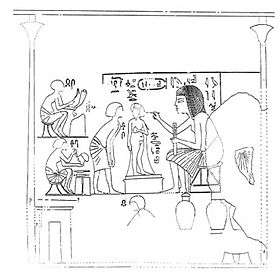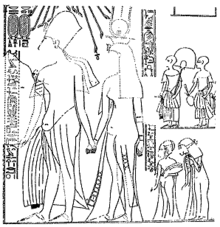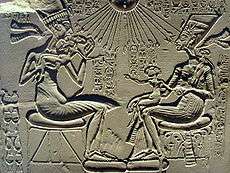Beketaten
| Beketaten in hieroglyphs | ||||||
|---|---|---|---|---|---|---|
| ||||||
 Queen Tiye's sculptor Yuti finishes a statue of Beketaten. From the Amarna tomb of Huya. | ||||||
Beketaten (14th century BCE) was an Ancient Egyptian princess of the 18th dynasty. Beketaten is considered to be the youngest daughter of Pharaoh Amenhotep III and his Great Royal Wife Tiye, thus the sister of Pharaoh Akhenaten.[1] Her name means "Handmaid of Aten".
Biography
Beketaten is mainly known from the tomb of Huya, the steward of Queen Tiye in Amarna.[2]
Beketaten is shown with Queen Tiye in two separate banquet scenes. Queen Tiye is shown seated opposite Pharaoh Akhenaten and Queen Nefertiti. In one scene Beketaten is shown seated on a small chair next to her mother Tiye, and in the other banquet scene Beketaten is shown standing next to Tiye. On the east wall of Huya's tomb Akhenaten is shown leading his mother Tiye to a temple. They are accompanied by the Beketaten as they enter the temple.[2]
The lintel on the North Wall shows a depiction of the two royal families. On the right side Amenhotep III is shown seated opposite Queen Tiye who is accompanied by the princess Beketaten. Three female attendants are shown behind Tiye.[2]


Proposed alternative identities
Beketaten's only known title is King's Daughter of his Body. It is likely that she died young since she is not mentioned in the historical records after Queen Tiye's death. Some scholars have speculated that Nebetah, Amenhotep III's youngest daughter, was identical with Beketaten.[3] However, no evidence proves that they are the same person.
According to one theory Beketaten was in fact a daughter of Akhenaten and his secondary wife Kiya. She may be identical with the princess who is shown with Kiya, whose name ends in -aten but whose full name was lost. After Kiya's demise her depictions were re-carved to show Meritaten and Ankhesenpaaten with their daughters Meritaten Tasherit and Ankhesenpaaten Tasherit (who might have been fictional and made up to fill the place of Kiya's child on these depictions).[4] This theory is partially based on the fact that Beketaten was never named king's sister in the scenes from Amarna, but only king's bodily daughter. She never appears alongside the daughters of Nefertiti, leading to the conjecture that she must be the daughter of Akhenaten by another wife who may be Kiya. After the death of her mother, Beketaten may have been raised by her grandmother Tiye.[5] A wine docket mentioning Beketaten dates to year 13 and it has been proposed that she inherited Kiya's estates after her death.[6]
In Fiction
Amarnan Kings series
Beketaten is the central character in a series of five historical novels written by Max Overton and published by Writers Exchange E-Publishing. The novels follow the life of Beketaten from early childhood through to the end of her life in the reign of Ramses the Great. The five books cover her life during the reigns of Akhenaten (Scarab-Akhenaten), Smenkhkare (Scarab-Smenkhkare), Tutankhamen (Scarab-Tutankhamen), Ay (Scarab-Ay), and Horemheb (Scarab-Horemheb). A sixth novel in the series is set in 1960s Egypt and deals with the discovery of Beketaten's tomb.
The Egyptian
Beketaten is featured as a secondary character in Mika Waltari's novel The Egyptian, going under the name Baketaton (and named Bakethamun in the movie). In the novel, she is wed to Horemheb, Egypt's warlord though of common blood, that has desired her (and her royal bloodline) since youth. However, she resents being touched by a simple commoner, and makes good on her promise that if he ever touches her again, she will lie with every man in Thebes, starting a rumor she is the incarnation of the goddess Bast.
Sources
- ↑ Aidan Dodson & Dyan Hilton, The Complete Royal Families of Ancient Egypt, Thames & Hudson (2004), p.154
- 1 2 3 N. de G. Davies, The rock tombs of El-Amarna, Parts III and IV, 1905 (Reprinted 2004), The Egypt Exploration Society, ISBN 0-85698-160-5
- ↑ Joyce Tyldesley: Nefertiti – Egypt's Sun Queen
- ↑ Dr. Marc Gabolde: The End of the Amarna Period
- ↑ Kramer, Enigmatic Kiya, from: A Delta-man in Yebu edited by A. K. Eyma, C. J. Bennett,Universal-Publishers, 2003
- ↑ Jacobus van Dijk, A noble lady from Mitanni and other royal favorites from the eighteenth dynasty, from Essays on ancient Egypt in honour of Herman te Velde, Brill, 1997
